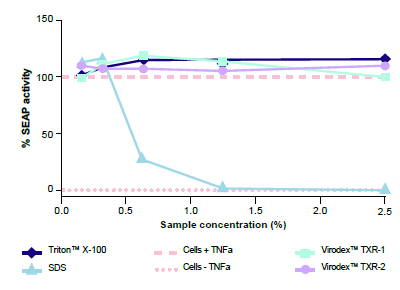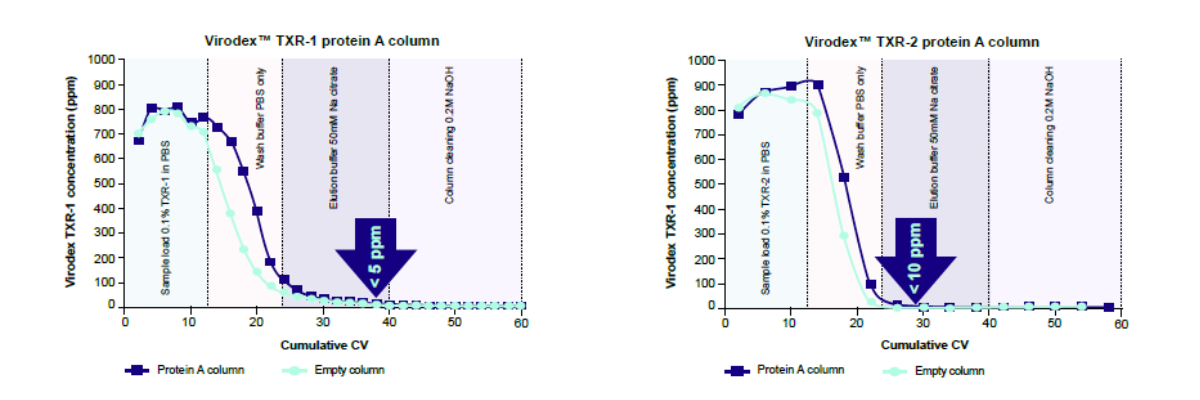EXCLUSIVE WHITEPAPER: Next-generation Triton™ X-100 replacements for pharmaceutical bioprocessing
Explore some snippets from our whitepaper...
Virodex™ as a solution to the ban of Triton™ X-100
To address the needs of the biopharmaceutical industry, we developed two chemically distinct detergents, Virodex™ TXR-1 and Virodex™ TXR-2. To facilitate their adoption in biopharmaceutical manufacturing processes, the Virodex™ detergents are compendial-grade materials manufactured to cGMP EXCiPACT standard. Both Virodex™ detergents show equivalent or better cell lysis and virus inactivation (VI) activity than Triton™ X-100. The Virodex™ detergents were also compared to three competitor products in VI tests and were shown to outperform the competitors in this important application (Fig.1).
 Figure 1 VI by three competitors compared to Virodex™ TXR-1 and TXR-2 and Triton™ X-100. All detergents were tested at 22 °C at a concentration of 0.1 % (v/v), unless indicated otherwise. The dotted red line indicates the log-reduction factor (LRF) at which no additional virus can be detected.
Figure 1 VI by three competitors compared to Virodex™ TXR-1 and TXR-2 and Triton™ X-100. All detergents were tested at 22 °C at a concentration of 0.1 % (v/v), unless indicated otherwise. The dotted red line indicates the log-reduction factor (LRF) at which no additional virus can be detected.
Virodex™ and biologic product integrity
The Virodex™ detergents are non-denaturing detergents that do not affect the structure of proteins, making them ideal reagents for processes that generate protein-based therapeutics or non-enveloped viral vectors used in CGT products.

Virodex™ TXR-1 and TXR-2 do not affect the enzymatic activity of secreted embryonic alkaline phosphate (SEAP) activity at concentrations up to 2.5 %, and their protein compatibility is equivalent to that of Triton™ X-100. Good protein compatibility is consistent with the non-ionic nature of the Virodex™ detergents. The anionic detergent sodium dodecyl sulphate (SDS) shows strong enzyme inactivation at concentrations > 0.3 % (Fig.2).
Figure 2 Activity of SEAP after detergent treatment: Expression of SEAP by HEK-293T cells was induced by treatment with tumor necrosis factor alpha (TNFa) and 100 % activity was defined as SEAP activity in untreated controls (pink dashed line). Base-line SEAP activity (0 %) was determined using cells that were not induced with TNFa (pink dotted line). Following TNFa activation (24 h) cells were treated with detergents for 2 h at 37 °C and then an aliquot of the cell culture medium was mixed with HEK-Blue Detection medium (Invivogen) and incubated for 24 h at 37 °C and 5 % CO2.Enzymatic activity was monitored by measuring the absorbance at 620 nm using a Cytation 5 plate reader (BioTek).
Compatibility with traditional Protein A chromatography for detergent removal from final drug product
Analytical detection methods were utilised to assess the affinity of the Virodex products to protein A resin, wherein no binding was seen demonstrating the ease of depletion in standard downstream processing (Fig.3).

Figure 3 Protein A column affinity of Virodex™ TXR-1 and TXR-2. Protein A resin affinity was assessed using MabCaptureC™; MiniChrom columns (ThermoFisher1). Virodex™ detergents in chromatography eluates was measured by HPLC-ELSD. The limit of quantification was 5 ppm for Virodex™ TXR-1 and 10 ppm for Virodex™ TXR-2. One column volume (CV) was 1 mL.
Choose Virodex™: Effective, sustainable, REACH compliant alternatives to Triton™ X-100
1. https://www.fishersci.fi/shop/products/mabcapturec-minichrom-column/30019344
Triton is a trademark of The Dow Chemical Company or an affiliated company of Dow.
Next-generation Triton™ X-100 replacements for pharmaceutical bioprocessing


Virodex™ TXR-1
.png&mn=healthcare&w=768&xr=0&yr=0&xfp=6&yfp=6&hash=7501F6B479657D736FB9923FF8239DF019C138999FEC74AA)
Virodex™ TXR-2
View our most recent blogs:

Croda welcomes Thomas Riermeier as new President of Life Sciences

Croda Pharma launches a new bioprocessing solution for shear stress in mammalian cell culture
